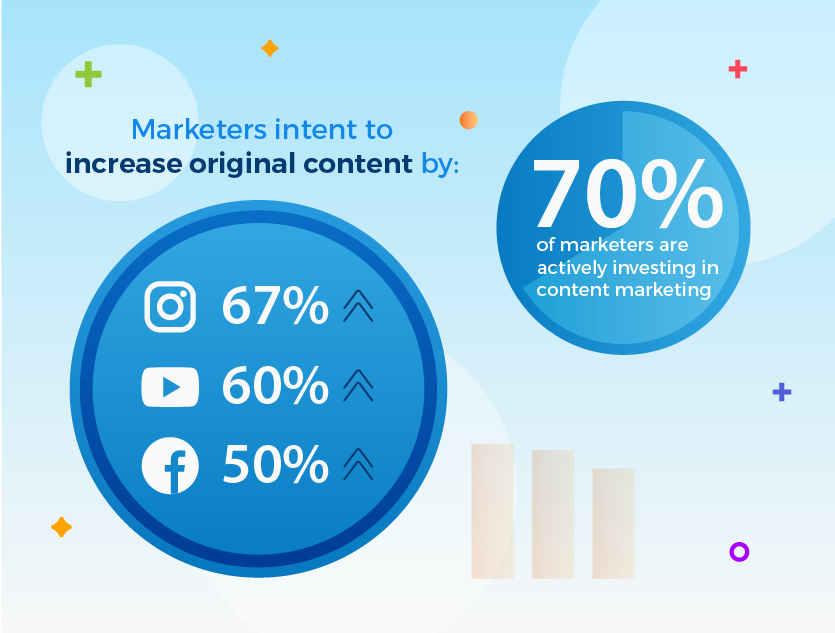

What is Content Marketing?

All you need to know about content marketing and the best ways to achieve your goals.
There’s a growing demand for content marketing. Today, more companies are seeing the need to engage in content marketing for a competitive edge. Based on a 2020 study by HubSpot, 70% of marketers are actively investing in content marketing.
In a 2020 Social Media Marketing Industry Report by the Social Media Examiner, marketers indicated their intent to increase original content by 67% on Instagram, 50% on Facebook, and 60% on YouTube.
The report also showed that social media efforts have generated more exposure for 86% of businesses, with 78% reporting positive results.

The competition is getting fiercer as companies invest more money in content marketing. Based on a 2020 B2B Content Marketing Report by CMI, 84% of marketers in B2B outsource their content creation activities, believing professionally produced content creates a better result.
But what exactly is “content marketing”? And how can it help your company?
According to the Content Marketing Institution (CMI), content marketing is a strategy of “…creating and distributing valuable, relevant and consistent content.” This content can help to attract a defined audience and lead to customer action, which isn’t necessarily buying your product. It could be subscribing to an email newsletter, or sharing your content. Content marketing isn’t about the hard sell, its outcomes are more ambitious.

With the audience as priority, the content you create has to be consumer-centric. It should answer their questions and pique their interest — whatever that may be — which requires good storytelling.

How?
We can do this through various types of content, depending on what works best for the industry we’re targeting, and the way audiences consuming this content. Some content types include informative articles, e-books, videos, infographics, blogs, webinars and podcasts.

Why?
Good content marketing raises awareness about the company, builds a relationship with prospective customers, and gains their trust and loyalty over time. Growing these bonds will increase chance of consumers choosing your products over the competition. That’s the power of content marketing.
A boost in influencing power
Another benefit of content marketing is that it can help your company become a thought leader, or an influencer in the B2B sector.
As traditional marketing budgets shrink, focusing on niche content marketing could be the way to increase engagement and trust with your audience. Becoming a credible and authoritative resource on topics that will interest prospective customers will make your company a trusted and valued expert in its industry.
Having a large audience depending on your knowledge gives you more influence and authority in the industry. By being an influencer in your niche, you will be offered more opportunities and can set higher rates for your products and services.

What’s the difference?
Content Marketing, Digital Marketing, and Inbound Marketing
“Content marketing”, “digital marketing”, and “inbound marketing” can be confusing. How do they differ?
Let’s tackle digital marketing and inbound marketing first.
Digital marketing encompasses all marketing efforts that use the internet and online-based digital technologies to connect with customers. If you’re an SME, you should definitely have a digital marketing strategy.
Digital marketing doesn’t differentiate between push and pull marketing tactics — any form of marketing that uses digital channels is considered digital marketing. Push marketing “pushes” brand products out to customers through tactics like ads on social media and sales display, while pull marketing “pulls” consumers in towards your products by tactics like blogging, reviews, and word-of-mouth.
Inbound marketing is a type of digital marketing that only uses pull marketing tactics. It’s a comprehensive approach for attracting prospective customers by improving the customer experience and building trust in a non-disruptive manner.
Now what about inbound marketing and content marketing?
Content marketing is a subset of inbound marketing as it only pulls customers, but through building relationships via the publishing of long-form content on topics that will interest prospective customers. It doesn’t include aspects like website design or copywriting.

Copywriting and Content Marketing
Okay, so you’ve got a clearer picture of how the different types of marketing work. But then where does “copywriting” come in?
Copywriting is a form of writing that is meant to attract and persuade readers to take a specific action, such as making a purchase or signing up to a webinar. It’s often comprised of short-form content, such as ads, sales, letters, and headlines. Copywriting can be used as pull and push marketing tactics.
In contrast, instead of persuading readers to buy your product, content marketing educates, informs, and entertains viewers to increase brand awareness and build credibility. Content marketing is also often much longer. Think books, emails, and articles, not just advertisements.
A quick and easy way to make a distinction is through comparing their lengths.
A brand video? Content marketing.
The catchy taglines on its advertisements? Copywriting.
A long thought leadership article on LinkedIn from an executive? Content marketing.
The short and snappy headline of the article? Copywriting.
It might be a slight difference, but it’s an important one as it can affect how it’s written and who you get to write it.
Best content marketing practices
If you’re just starting with content marketing, follow this list of best content marketing practices to one-up your competitors.

1. Be clear about your objectives
As with all marketing strategies, you need to plan before jumping in. Decide on your objectives for content marketing first. Do you want to increase brand awareness, drive traffic to your site, improve your SEO ranking, or gain more leads? Your objective will influence your tactics.
If you’re not yet clear of your objective, you can use the SMART framework (Specific, Measurable, Attainable, Relevant, and Timely) as a guide. You can also adopt a design thinking approach to discover and address customer needs.
After you have decided on your goals, create content catered to achieve them, and then review as necessary.

2. Align your processes with a content calendar
Use a content calendar to plan the quantity and type of content you intend to disseminate. This allows you to have a better overview of your content marketing strategy.
While you should aim to publish frequently and consistently, the frequency might depend on several things including:
- Your marketing goals
- Type of content
- Audience preferences
- Available resources
The quality of your posts should also be prioritised over the quantity. One excellent blog post every month would draw a larger crowd than subpar weekly posts.
As a guide, aim to post 1-3 articles per week if you intend to create a blog. Videos understandably take longer and might not require the same frequency as articles, but if videos are your main form of content, aim to post consistently.
If your resources are tight and you’re unable to post often, intersperse your own blogs with guest posts, or your videos with other content types like gifs, illustrations or blogs. These can be useful in attracting new viewers to your site. Not only does it provide a slight respite from producing original content of the same form, but can add to brand authenticity by featuring industry experts.

3. Personalise the content to your audience
Take the time to understand your audiences and appeal to them by personalising your content.
You can create audience personas, which are fictional profiles representing your target audience, and refine the messages to cater to their needs.
For example, one of the personas for a youth fashion label could be a 18-year-old student named Rachel, who’s just entering University and wants to be seen as fashionable in front of her peers.
In contrast, the persona for a company selling specialty coffee could be 27-year-old Vicky, a lady working at a bank in the heart of the city. Price isn’t an issue to her; convenience, taste, and the status of having artisan coffee is more important.
Also, a health food brand could target 46-year-old Zac, an office worker who has been feeling his age in recent years and is willing to spend on quality food for himself and his wife.
After creating these personas, you can better visualise their needs and know how to appeal to them.

4. Do research and optimise your SEO
Before starting on any sort of content creation, it’s good practice to do research first. Find out the forms of content and topics popular in your niche; understand what your audience wants so that you can deliver it to them. For example, the customers of an urban thrift shop catered to young adults are likely to be interested in topics related to fashion, sustainability, and the environment.
Scout your competition – know what they’re writing about and how long their articles are. The ideal length of articles differs for different niches and audiences.
And don’t neglect keyword searches! Make a list of keywords related to your article to get keyword suggestions and use long-tail keywords favoured by your target audiences. You can check what keywords your competitors are already using, and match them.
If you need more ideas, explore free tools such as Ubersuggest to find which keywords get more traffic.
We used both Google and Ubersuggest to do a quick keyword search for “video games”, and suggestions included “video games list”, “best video games”, “video games free”, “video games Nintendo Switch”, and “video games for kids”.
If you’re a video games company and writing articles related to games, you can include these key terms in your article, or write content aimed at answering related questions.
The key is to optimise your SEO as much as you can so that Google can do half your work for you.

5. Tell a story
Now that you’re ready to produce your content, don’t forget the importance of storytelling.
Stories sell. Telling a story is the easiest way to capture their attention and lure them in. A good story can make your viewer empathise with you and build a good rapport between the customers and you.
But to really differentiate your content, your story doesn’t only need to be engaging. It needs to be unique, helpful, and relevant to them too.
What’s in it for your audience? Your content should answer a question of theirs, solve a problem, or at the very least, entertain them.
For example, content marketers often face the challenge of encouraging innovative thinking in their content strategy. We wrote an article about design thinking to share our approach with our readers. It’s relevant and shares ideas that our viewers could do with their own content, which entices them to continue reading.

6. Curate your content
Win people over with curated content. This refers to the selection of relevant content from various sources and value-adding to it.
Curate your content by providing insights and fresh information that can’t be found elsewhere. Offer internal data, include an in-depth analysis, or add commentary to existing content. Make your voice be heard.
For example, our weekly Click2View newsletter doesn’t only include content we create. Instead, we curate the best content picks that have been published that week from various brands’ channels and add our insights. One strategy is to compile lists, such as a list on the types of content in content marketing. Be smart about your content and reap the same benefits with less effort. (Subscribe to our newsletter if you haven’t already here)

7. Identify the best channel for your audience
Not only do different age groups prefer different social media platforms, but different social media platforms work for different countries, and different platforms are also more suitable for certain types of content marketing. Take note of what your target audience prefers and identify the best channel to reach them.
For example, Instagram targets those under 30, with common topics being beauty, lifestyle, and travel. If you want to market on Instagram, it’s better to do so in the form of videos and short posts.
Pinterest, in contrast, is more frequented by women under 50, and its layout suits infographics and illustrations more than long-form writing.
LinkedIn, a professional networking platform, is used most by working adults and professionals. 92% of B2Bs marketers use LinkedIn.
Adults also tend to prefer Facebook, which is more for B2C marketing than B2B. If you’re planning to use Facebook, linking articles and longer posts work best.
The social media platform you should use also depends on your region. Find out the right social media platform for your audiences in Asia here.

8. Choose the time and day to post your content
When you post your content affects how many viewers you get. People behave differently based on their geography and preferences, so different trends can arise for different target audiences.
Generally, for the most comments and social shares, post on Saturday. But if you want to generate the highest traffic, Monday is better. The best time to post is between 9.30am and 11am, but you can also post between 9pm and midnight for the most social shares and comments.
Experiment with your posting time and day and use Google Analytics to track the parameters to understand your audience’s behaviour and know what works best for you.

9. Use analytics to optimise your content
It helps to know your top-performing content for future replication. After posting your content, use analytics to monitor what works and what doesn’t. Check the metrics for user behaviour, engagement, SEO results and company revenue.
You can use tools like Google Analytics to optimise your website. The platform allows you to track your pages with the most traffic and conversion so that you can identify your best content. It can show trends and behaviour flow as well, allowing you to make the most informed choices to optimise your website.
The key to content marketing: Your audience
There is no fixed method to guarantee a successful content marketing. It’s crucial to first understand your audience and know the best way to engage with them. The beauty of content marketing on digital platforms is you can test at a relatively low cost and make changes based on the results. It’s a constantly evolving process.
In a world that’s getting more digitalised by the day, content marketing is becoming crucial if you want to give your company a cutting edge.
Need more advice on how to jump-start your content marketing? Contact our CEO Simon Kearney at [email protected] for more information.








